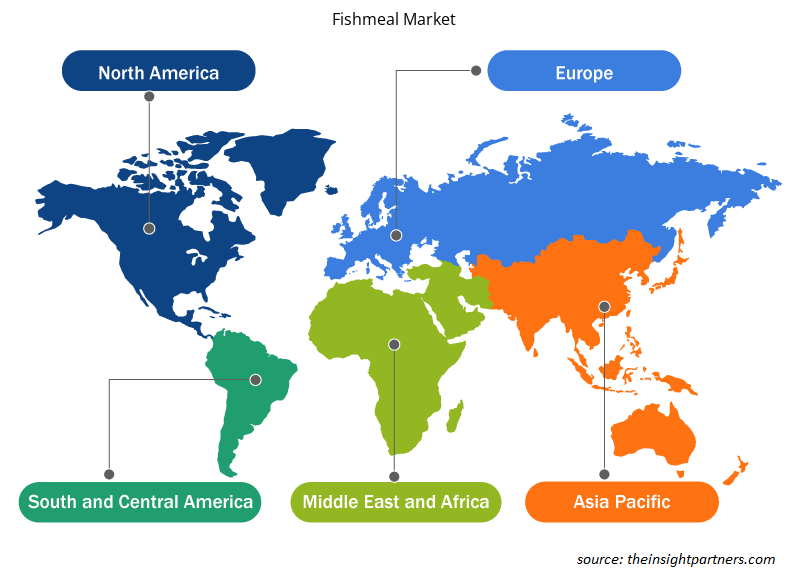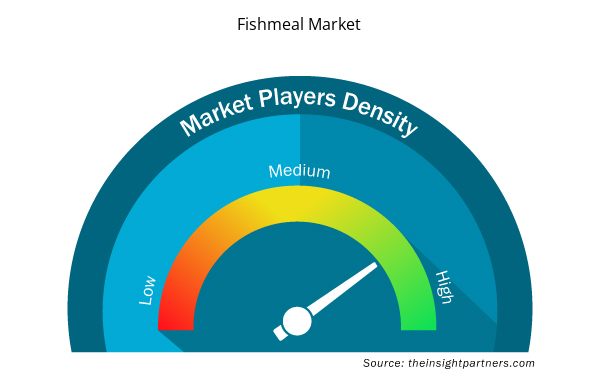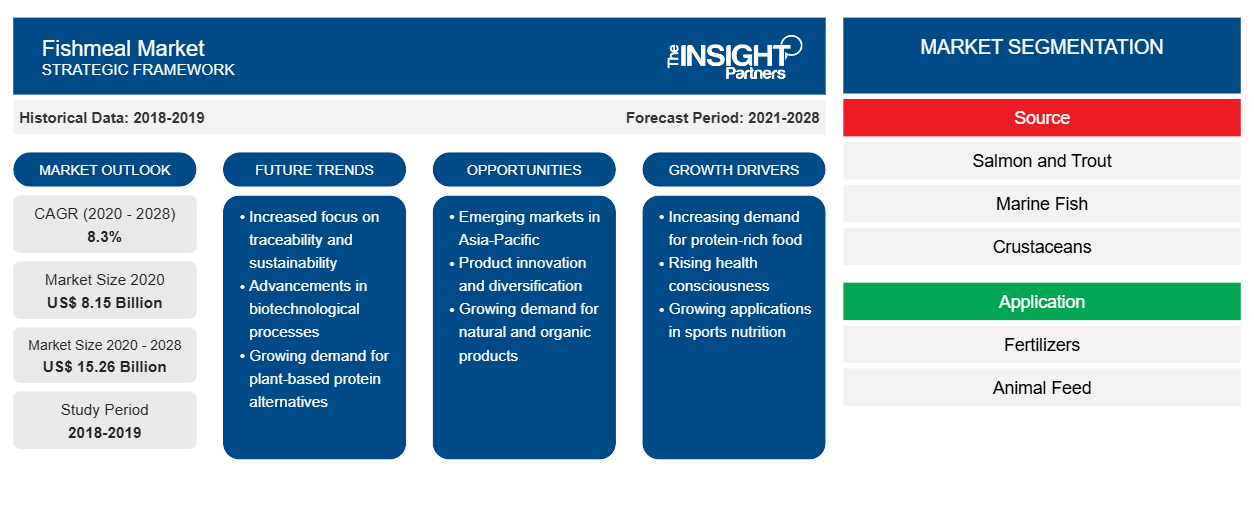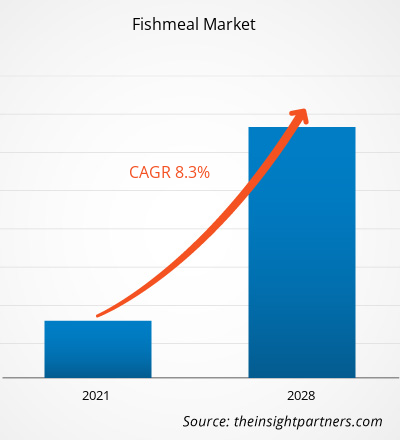Der Fischmehlmarkt hatte im Jahr 2020 einen Wert von 8.153,6 Millionen US-Dollar und soll bis 2028 einen Wert von 15.264,6 Millionen US-Dollar erreichen; von 2021 bis 2028 wird mit einer durchschnittlichen jährlichen Wachstumsrate von 8,3 % gerechnet.
Fischmehl wird aus Fischnebenprodukten der Lebensmittelverarbeitung und Filetierindustrie hergestellt. Es wird hauptsächlich als proteinreicher (60–72 %) Inhaltsstoff in Futtermitteln für Nutztiere und Aquakulturarten verwendet. Die Nachfrage nach Fischmehl übersteigt das Angebot; daher hat die Futtermittelindustrie die Zusammensetzung des Fischmehls in Futtermitteln erheblich verändert. Der Fischmehlmarkt hat im Laufe der Geschichte aufgrund der Entwicklung der Aquakultur aufgrund der steigenden Nachfrage nach Meeresfrüchten und der zunehmenden Abhängigkeit der Entwicklungsländer von der Aquakultur zur Lösung der Nahrungsmittelknappheit ein Wachstum erlebt. Außerdem ist Fischmehl von Natur aus nachhaltig, da es aus Abfallkomponenten anderer Industrien hergestellt wird. Daher ist es Teil verschiedener Umweltschutzprogramme. Der Markt profitiert dabei von nachhaltigen Praktiken wie dem ökologischen Landbau.
Im Jahr 2020 hatte der asiatisch-pazifische Raum den größten Umsatzanteil am globalen Fischmehlmarkt . Außerdem wird die Region im Prognosezeitraum voraussichtlich die höchste durchschnittliche jährliche Wachstumsrate verzeichnen. Der asiatisch-pazifische Raum umfasst mehrere große Volkswirtschaften wie Indien, China, Japan, Südkorea und Australien. Diese Länder erleben einen Aufschwung bei der Industrialisierung des Lebensmittelsektors und bei Urbanisierungsaktivitäten, was den wichtigsten Akteuren auf dem Fischmehlmarkt reichlich Gelegenheiten bietet . Im asiatisch-pazifischen Raum wird in den kommenden Jahren eine steigende Nachfrage nach Fischmehl erwartet , da zahlreiche kleine und mittlere inländische Akteure auf dem Markt vertreten sind. Im Prognosezeitraum wird der Fischmehlmarkt voraussichtlich eine enorme Nachfrage aus der Aquakultur- und Biolandwirtschaft verzeichnen, da er über ein sehr nahrhaftes Profil mit essentiellen Aminosäuren verfügt. Außerdem findet Fischmehl Verwendung in der Nutraceutika- , Pharma- und anderen Industrien. Der Fischmehlmarkt im asiatisch-pazifischen Raum wird im Prognosezeitraum voraussichtlich aufgrund des enormen Wachstums des Aquakultursektors, insbesondere in Indien und China, wachsen. Darüber hinaus treiben die steigende Bevölkerungszahl und die zunehmende staatliche Unterstützung das Marktwachstum in der Region voran.
Passen Sie diesen Bericht Ihren Anforderungen an
Sie erhalten kostenlos individuelle Anpassungen an jedem Bericht, einschließlich Teilen dieses Berichts oder einer Analyse auf Länderebene, eines Excel-Datenpakets sowie tolle Angebote und Rabatte für Start-ups und Universitäten.
- Holen Sie sich die wichtigsten Markttrends aus diesem Bericht.Dieses KOSTENLOSE Beispiel umfasst eine Datenanalyse von Markttrends bis hin zu Schätzungen und Prognosen.
Die COVID-19-Pandemie hat sich durch Unterbrechungen der Lieferkette negativ auf die Fischereiindustrie ausgewirkt. Der Rückgang der Nachfrage nach Meeresfrüchten hat zu einer verringerten Fischproduktion geführt. Die geringe Nachfrage nach Fisch reduzierte die Aktivitäten der Fischereiflotte, was sich negativ auf die Produktion von Fischnebenprodukten, insbesondere Fischmehl , auswirkte . Mit dem Beginn der weltweiten Impfkampagnen erholen sich die Volkswirtschaften jedoch wieder und die Industrie verzeichnet eine Nachfrage nach ihren Produkten. Verschiedene Regierungen ergreifen außerdem Initiativen, um die Verluste der Fischereiindustrie aufgrund dieser Pandemie zu minimieren. Daher wird erwartet, dass der Fischmehlmarkt in den kommenden Jahren wachsen wird.
Markteinblicke
Steigende Nachfrage nach proteinreichem Tierfutter
Die Industrialisierung der Tierhaltung hat die Nachfrage nach proteinreichen Futterzutaten erhöht , um die Futterverwertung zu steigern. Industriell gezüchtetes Vieh wird hauptsächlich mit Konzentraten aus Getreide und pflanzlichen Proteinen wie Sojamehl gefüttert, um die Gewichtszunahme zu unterstützen und proteinreiches Fleisch zu produzieren. Nutztiere sind auf Proteine und andere Elemente als Bausteine angewiesen, die für ihr Wachstum unerlässlich sind. Proteine in Tierfutter sind eine ausgezeichnete Energiequelle und enthalten essentielle Aminosäuren wie Lysin und Methionin . Das wachsende Bewusstsein über die gesundheitlichen Vorteile von Proteinen für die Tiergesundheit hat eine erhebliche Nachfrage nach verschiedenen Proteinfuttermitteln wie tierischen Proteinmehlen, Federmehl, Fischmehl , Knochenmehl und Blutmehl geschaffen. Fischmehl ist eine reichhaltige Quelle für Proteine, Mineralien und Fettsäuren und wird vom Vieh beim Verzehr leicht verdaut. Hochwertiges Fischmehl ermöglicht die Zusammenstellung nährstoffreicher Tiernahrung und fördert deren optimales Wachstum. Da Nutztiere und Nutztiere einen bedeutenden Beitrag zur globalen Lebensmittelversorgungskette leisten, steigt die Nachfrage nach proteinreichem, nahrhaftem Tierfutter und wird im Prognosezeitraum voraussichtlich anhalten. Die ständig steigende Nachfrage nach proteinreichem Tierfutter zur Förderung des Wachstums von Nutztieren in allen Lebensphasen treibt den Fischmehlmarkt insgesamt erheblich an.
Quelle Einblicke
Der globale Fischmehlmarkt ist nach Herkunft in Lachs, Makrele, Sardelle, Lodde und andere unterteilt. Im Jahr 2020 machte das Sardellensegment den größten Umsatzanteil aus. Sardellen kommen hauptsächlich in SAM vor, insbesondere in Peru. Das Volumen der aus peruanischen Sardellen hergestellten Fischmehlproduktion entspricht dem Bedarf der Hälfte der weltweiten Produktion von gefüttertem Zuchtfisch. Der Markt für das Sardellensegment dürfte im Prognosezeitraum aufgrund der großen Verfügbarkeit von Sardellen in großen Mengen wachsen. Die hohe Verfügbarkeit von Sardellen wirkt sich auch positiv auf die globale Ernährungssicherheit aus.
Anwendungseinblicke
Basierend auf der Anwendung ist der globale Fischmehlmarkt in Tierfutter, Landwirtschaft und andere unterteilt. Im Jahr 2020 machte das Segment Tierfutter den größten Umsatzanteil aus. Fischmehl ist ein leicht verdaulicher Futterbestandteil mit einem hohen Energiegehalt pro Gewichtseinheit. Es enthält wenig Kohlenhydrate und ist eine ausgezeichnete Quelle für Vitamine, Mineralien, Öle (Lipide) und Proteine. Viele kommerzielle Fischmehle werden aus kleinen und knochigen Fischen hergestellt, die nicht für den menschlichen Verzehr geeignet sind, oder aus Nebenprodukten der Fischverarbeitungsindustrie. Daher macht die Aufwertung von Nebenprodukten das Fischmehl als Tierfutter wirtschaftlich. Daher treibt die Verbesserung von Tierfutter mit Hilfe von Fischmehl das Marktwachstum für dieses Segment voran.
TripleNine , The Scoular Company, FF SKAGEN A/S, Pelagia AS, Soytex LTD, Pesquera Diamante SA , TASA , Oceana Group Limited, Omega Protein Corporation und COPEINCA sind einige etablierte Akteure auf dem globalen Fischmehlmarkt . Unternehmen auf dem Markt verfolgen Strategien wie Produktentwicklungen, Werkserweiterungen sowie Fusionen und Übernahmen, um ihre Präsenz weltweit auszubauen und die wachsende Nachfrage der Endverbraucher zu befriedigen. So brachte Scoular im September 2021 für sein wachsendes Fischmehlgeschäft die neue Marke Encompass auf den Markt .
Regionale Einblicke in den Fischmehlmarkt
Die regionalen Trends und Faktoren, die den Fischmehlmarkt im Prognosezeitraum beeinflussen, wurden von den Analysten von Insight Partners ausführlich erläutert. In diesem Abschnitt werden auch die Fischmehlmarktsegmente und die Geografie in Nordamerika, Europa, im asiatisch-pazifischen Raum, im Nahen Osten und Afrika sowie in Süd- und Mittelamerika erörtert.

- Holen Sie sich die regionalspezifischen Daten zum Fischmehlmarkt
Umfang des Fischmehl-Marktberichts
| Berichtsattribut | Details |
|---|---|
| Marktgröße im Jahr 2020 | 8,15 Milliarden US-Dollar |
| Marktgröße bis 2028 | 15,26 Milliarden US-Dollar |
| Globale CAGR (2020 - 2028) | 8,3 % |
| Historische Daten | 2018-2019 |
| Prognosezeitraum | 2021-2028 |
| Abgedeckte Segmente | Nach Quelle
|
| Abgedeckte Regionen und Länder | Nordamerika
|
| Marktführer und wichtige Unternehmensprofile |
|
Dichte der Akteure auf dem Fischmehlmarkt: Auswirkungen auf die Geschäftsdynamik verstehen
Der Fischmehlmarkt wächst rasant, angetrieben durch die steigende Nachfrage der Endverbraucher aufgrund von Faktoren wie sich entwickelnden Verbraucherpräferenzen, technologischen Fortschritten und einem größeren Bewusstsein für die Vorteile des Produkts. Mit steigender Nachfrage erweitern Unternehmen ihr Angebot, entwickeln Innovationen, um die Bedürfnisse der Verbraucher zu erfüllen, und nutzen neue Trends, was das Marktwachstum weiter ankurbelt.
Die Marktteilnehmerdichte bezieht sich auf die Verteilung der Firmen oder Unternehmen, die in einem bestimmten Markt oder einer bestimmten Branche tätig sind. Sie gibt an, wie viele Wettbewerber (Marktteilnehmer) in einem bestimmten Marktraum im Verhältnis zu seiner Größe oder seinem gesamten Marktwert präsent sind.
Die wichtigsten auf dem Fischmehlmarkt tätigen Unternehmen sind:
- DreifachNeun
- Die Scoular Company
- FF SKAGEN A/S
- Pelagia AS
- Soytex LTD
Haftungsausschluss : Die oben aufgeführten Unternehmen sind nicht in einer bestimmten Reihenfolge aufgeführt.

- Überblick über die wichtigsten Akteure auf dem Fischmehlmarkt
Bericht-Spotlights
- Fortschrittliche Branchentrends auf dem globalen Fischmehlmarkt helfen den Akteuren bei der Entwicklung wirksamer langfristiger Strategien
- In Industrie- und Entwicklungsländern angewandte Strategien für Unternehmenswachstum
- Quantitative Analyse des globalen Fischmehlmarktes von 2019 bis 2028
- Schätzung der Nachfrage nach Fischmehl in verschiedenen Branchen
- Aktuelle Entwicklungen zum Verständnis des Wettbewerbsmarktszenarios und der Nachfrage nach Fischmehl
- Markttrends und -aussichten in Verbindung mit Faktoren, die das Wachstum des Fischmehlmarktes vorantreiben und bremsen
- Entscheidungsprozess durch das Verständnis von Strategien, die das kommerzielle Interesse im Hinblick auf das Wachstum des globalen Fischmehlmarktes untermauern
- Fischmehlmarktgröße an verschiedenen Knotenpunkten des Marktes
- Detaillierte Übersicht und Segmentierung des globalen Fischmehlmarktes sowie seiner Dynamik in der Branche
- Fischmehlmarktgröße in verschiedenen Regionen mit vielversprechenden Wachstumschancen
Fischmehlmarkt , nach Quelle
- Lachs
- Makrele
- Sardelle
- Lodde
- Sonstiges
Fischmehlmarkt , nach Anwendung
Firmenprofile
- DreifachNeun
- Die Scoular Company
- FF SKAGEN A/S
- Pelagia AS
- Soytex LTD
- Pesquera Diamante SA
- TASA
- Oceana Group Limited
- Omega Protein Corporation
- COPEINCA
- Historische Analyse (2 Jahre), Basisjahr, Prognose (7 Jahre) mit CAGR
- PEST- und SWOT-Analyse
- Marktgröße Wert/Volumen – Global, Regional, Land
- Branche und Wettbewerbsumfeld
- Excel-Datensatz


- Travel Vaccines Market
- Nuclear Decommissioning Services Market
- Digital Language Learning Market
- Cut Flowers Market
- Pressure Vessel Composite Materials Market
- Small Molecule Drug Discovery Market
- Analog-to-Digital Converter Market
- Webbing Market
- Drain Cleaning Equipment Market
- Identity Verification Market

Report Coverage
Revenue forecast, Company Analysis, Industry landscape, Growth factors, and Trends

Segment Covered
This text is related
to segments covered.

Regional Scope
North America, Europe, Asia Pacific, Middle East & Africa, South & Central America

Country Scope
This text is related
to country scope.
Häufig gestellte Fragen
Industrial livestock production has ensured a high volume of meat production at low cost by taking advantage of economies of scale. The availability of dairy and meat products at low prices has led to an increase in their consumption and thereby contributed to the growth of the industrial livestock production industry. The robust growth witnessed by the industrial livestock production sector has spurred the demand for high-quality animal feed used in rearing a range of livestock, including cattle, swine, goats, chicken, fish, and shrimps. The crucial role played by industrial livestock production in meeting the nutritional requirement of humans worldwide has led to the proliferation of industrial livestock farms across the world and augmented the sale of animal feed and its ingredients. Thus, the rise in industrial livestock production is fueling the market growth of fishmeal, as fishmeal is used as a natural protein-rich ingredient in animal feed.
In 2020, China held the largest market share in the global fishmeal market. China is one of the leading aquaculture producers; the country also accounts for the significant consumption of seafood. The aquaculture industry in the country has witnessed consistent growth over the past two decades and is expected to witness similar growth during the forecast period. Moreover, the growing middle-class population and increasing disposable income have led to higher demand for a variety of processed seafood products. The higher demand for seafood is expected to contribute to the fishmeal market growth in China.
In 2020, the anchovy segment accounted for the largest market share. The anchovies are majorly found in SAM, especially Peru. The volume of fishmeal production manufactured from Peruvian anchovies is equivalent to requirement of half of the global fed farmed fish production. The anchovy segment has a promising growth over forecast period as anchovies are available in ample quantity. The high availability of anchovies also has positive impact on global food security.
On the basis of application, animal feed is the fastest growing segment. Fishmeal is a highly digestible feed ingredient, carrying high amount of energy per unit weight. The ingredient also contains little carbohydrate and is an excellent source of vitamins, minerals, oils (lipids), and protein. Most commercial fishmeal is made from small, bony fishes which are not suitable for human consumption or manufactured from by-products of fish processing industry. Therefore, the valorization of by-products makes the fishmeal animal feed economical. Therefore, the enhancement of animal feed with the help of fishmeal is driving the demand for the product.
The major players operating in the global fishmeal market are FF SKAGEN A/S, OCEANA GROUP LIMITED, Omega Protein Corporation, Pelagia AS, TASA, Pesquera Diamante S.A., The Scoular Company, TripleNine, COPEINCA, and Soytex LTD.
In 2020, Asia-Pacific held the largest revenue share of the global fishmeal market. Also, the region registered the highest CAGR in 2020. Asia-Pacific region is anticipated to propel the fishmeal demand owing to the presence of numerous small and medium level domestic players in the market. The fishmeal market is expected to witness huge demand from the aquaculture and organic farming industries due to its highly nutritious profile containing essential amino acids. Additionally, the rising population, and the presence of government support are the other drivers for the market growth in the region.
Trends and growth analysis reports related to Food and Beverages : READ MORE..
The List of Companies - Fishmeal Market
- TripleNine
- The Scoular Company
- FF SKAGEN A/S
- Pelagia AS
- Soytex LTD
- Pesquera Diamante S.A.
- TASA
- Oceana Group Limited
- Omega Protein Corporation
- COPEINCA
The Insight Partners performs research in 4 major stages: Data Collection & Secondary Research, Primary Research, Data Analysis and Data Triangulation & Final Review.
- Data Collection and Secondary Research:
As a market research and consulting firm operating from a decade, we have published and advised several client across the globe. First step for any study will start with an assessment of currently available data and insights from existing reports. Further, historical and current market information is collected from Investor Presentations, Annual Reports, SEC Filings, etc., and other information related to company’s performance and market positioning are gathered from Paid Databases (Factiva, Hoovers, and Reuters) and various other publications available in public domain.
Several associations trade associates, technical forums, institutes, societies and organization are accessed to gain technical as well as market related insights through their publications such as research papers, blogs and press releases related to the studies are referred to get cues about the market. Further, white papers, journals, magazines, and other news articles published in last 3 years are scrutinized and analyzed to understand the current market trends.
- Primary Research:
The primarily interview analysis comprise of data obtained from industry participants interview and answers to survey questions gathered by in-house primary team.
For primary research, interviews are conducted with industry experts/CEOs/Marketing Managers/VPs/Subject Matter Experts from both demand and supply side to get a 360-degree view of the market. The primary team conducts several interviews based on the complexity of the markets to understand the various market trends and dynamics which makes research more credible and precise.
A typical research interview fulfils the following functions:
- Provides first-hand information on the market size, market trends, growth trends, competitive landscape, and outlook
- Validates and strengthens in-house secondary research findings
- Develops the analysis team’s expertise and market understanding
Primary research involves email interactions and telephone interviews for each market, category, segment, and sub-segment across geographies. The participants who typically take part in such a process include, but are not limited to:
- Industry participants: VPs, business development managers, market intelligence managers and national sales managers
- Outside experts: Valuation experts, research analysts and key opinion leaders specializing in the electronics and semiconductor industry.
Below is the breakup of our primary respondents by company, designation, and region:

Once we receive the confirmation from primary research sources or primary respondents, we finalize the base year market estimation and forecast the data as per the macroeconomic and microeconomic factors assessed during data collection.
- Data Analysis:
Once data is validated through both secondary as well as primary respondents, we finalize the market estimations by hypothesis formulation and factor analysis at regional and country level.
- Macro-Economic Factor Analysis:
We analyse macroeconomic indicators such the gross domestic product (GDP), increase in the demand for goods and services across industries, technological advancement, regional economic growth, governmental policies, the influence of COVID-19, PEST analysis, and other aspects. This analysis aids in setting benchmarks for various nations/regions and approximating market splits. Additionally, the general trend of the aforementioned components aid in determining the market's development possibilities.
- Country Level Data:
Various factors that are especially aligned to the country are taken into account to determine the market size for a certain area and country, including the presence of vendors, such as headquarters and offices, the country's GDP, demand patterns, and industry growth. To comprehend the market dynamics for the nation, a number of growth variables, inhibitors, application areas, and current market trends are researched. The aforementioned elements aid in determining the country's overall market's growth potential.
- Company Profile:
The “Table of Contents” is formulated by listing and analyzing more than 25 - 30 companies operating in the market ecosystem across geographies. However, we profile only 10 companies as a standard practice in our syndicate reports. These 10 companies comprise leading, emerging, and regional players. Nonetheless, our analysis is not restricted to the 10 listed companies, we also analyze other companies present in the market to develop a holistic view and understand the prevailing trends. The “Company Profiles” section in the report covers key facts, business description, products & services, financial information, SWOT analysis, and key developments. The financial information presented is extracted from the annual reports and official documents of the publicly listed companies. Upon collecting the information for the sections of respective companies, we verify them via various primary sources and then compile the data in respective company profiles. The company level information helps us in deriving the base number as well as in forecasting the market size.
- Developing Base Number:
Aggregation of sales statistics (2020-2022) and macro-economic factor, and other secondary and primary research insights are utilized to arrive at base number and related market shares for 2022. The data gaps are identified in this step and relevant market data is analyzed, collected from paid primary interviews or databases. On finalizing the base year market size, forecasts are developed on the basis of macro-economic, industry and market growth factors and company level analysis.
- Data Triangulation and Final Review:
The market findings and base year market size calculations are validated from supply as well as demand side. Demand side validations are based on macro-economic factor analysis and benchmarks for respective regions and countries. In case of supply side validations, revenues of major companies are estimated (in case not available) based on industry benchmark, approximate number of employees, product portfolio, and primary interviews revenues are gathered. Further revenue from target product/service segment is assessed to avoid overshooting of market statistics. In case of heavy deviations between supply and demand side values, all thes steps are repeated to achieve synchronization.
We follow an iterative model, wherein we share our research findings with Subject Matter Experts (SME’s) and Key Opinion Leaders (KOLs) until consensus view of the market is not formulated – this model negates any drastic deviation in the opinions of experts. Only validated and universally acceptable research findings are quoted in our reports.
We have important check points that we use to validate our research findings – which we call – data triangulation, where we validate the information, we generate from secondary sources with primary interviews and then we re-validate with our internal data bases and Subject matter experts. This comprehensive model enables us to deliver high quality, reliable data in shortest possible time.


 Holen Sie sich ein kostenloses Muster für diesen Bericht
Holen Sie sich ein kostenloses Muster für diesen Bericht